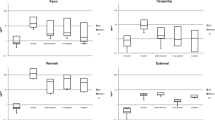Abstract
Two field studies were carried out in 1987 and 1991 in order to evaluate the effect of chronic exposure to solvent mixture on liver enzyme patterns. The results in 33 workers who participated in both studies and had complete sets of data are presented. The magnitude of chemical workload was assessed by means of ambient air monitoring and biomonitoring of solvent concentrations. Alanine aminotransferase, aspartate aminotransferase and γ-glutamyl transpeptidase were used as markers for possible biological effects. No dose-response relationship was found between exposure to complex solvent mixtures in ambient air, reaching and sometimes even exceeding the threshold limit values for mixtures, and liver enzyme activities. Self-reported alcohol intake was the only factor identified as statistically related to increased liver enzyme activity.
Similar content being viewed by others
References
Chen JD, Wang JD, Jang JP, Chen YY (1991) Exposure to mixtures of solvents among paint workers and biochemical alterations of liver function. Br J Ind Med 48:696–701
Cornish HH, Adefuin J (1967) Potentiation of carbon tetrachloride toxicity by aliphatic alcohols. Arch Environ Health 14:447–449
Forth W, Henschler D, Rummel W (1990) Pharmakologie und Toxikologie. BI Wissenschaftsverlag, Mannheim
Freundt KJ (1988) Berufliche Lösungsmittel-Exposition und Trinkalkohol: Toxikologische Begutachtung im Strafverfahren. Med Sach 84:62–66
Freundt KJ (1989) Gefahrstoff-Expositionen and Alkoholkonsum — Interferenzreaktionen, gesundheitliche Risiken. 21. Deutscher Kongress für Arbeitsschutz und Arbeitsmedizin, pp 233–256, Hrsg: Bundesarbeitsgemeinschaft für Arbeitssicherheit, Düsseldorf
Greim H, Dessau W (1985) Kombinationswirkung organischer Lösungsmittel. Schriftenreihe der Bundesanstalt für Arbeitsschutz, Dortmund
Kurppa K, Husman K (1982) Car painters' exposure to a mixture of organic solvents. Scand J Work Environ Health 8:137–140
Lundberg I, Hakansson M (1985) Normal serum activities of liver enzymes in Swedish paint industry workers with heavy exposure to organic solvents. Br J Ind Med 42:596–600
Maling HM, Stripp B, Sipes IG, Highman B, Saul W, Williams MA (1975) Enhanced hepatotoxicity of carbon tetrachloride, thioacetamide, and dimethyl-nitrosamine by pretreatment of rats with ethanol and some comparison with potentiation by isopropanol. Toxicol Appl Pharmacol 33:291–308
Müller-Alberti A, Kessel R (1988) Korrelation zwischen Alkoholkonsum und Laborbefunden bei gesunden männlichen Arbeitern. Arbeitsmed Sozialmed Präventivmed 23:81–84
Nakajima T, Wang R-S, Murayama N (1993) Immunochemical assessment of the influence of nutritional, physiological and environmental factors on the metabolism of toluene. Int Arch Occup Environ Health 65:127–130
Rasmussen K, Brogren C-H, Sabroe S (1993) Subclinical affection of liver and kidney function and solvent exposure. Int Arch Occup Environ Health 64:445–448
Rees D, Soderlund N, Cronje R, Song E, Kielkowski D, Myers J (1993) Solvent exposure, alcohol consumption and liver injury in workers manufacturing paint. Scand J Work Environ Health 19:236–244
Schäcke G, Heydenreich-Adloff B, Lüdersdorf R, Fuchs A, Schafstedde F (1983) Zur Frage der Differenzierung von berufsbedingter Lösemittelexposition and alimentärer Alkoholbelastung anhand gebräuchlicher Leberfunktionsparameter. Bericht über die 23. Jahrestagung der Deutschen Gesellschaft für Arbeitsmedizin. Gemner Stuttgart
Traiger GJ, Plaa GL (1971) Differences in the potentiation of carbon tetrachloride in rats by ethanol and isopropanol pretreatment. Toxicol Appl Pharmacol 20:105–112
Triebig G (1992) Gesundheitsgefährdung durch organische Losungsmittel unter besonderer Berücksichtigung der Neurotoxizität. Arbeitsmedizin aktuell, vol 30. Gustav Fischer, Stuttgart
Triebig G, Weltle D, Schaller K-H, Valentin H (1985) Chronische Lösemittel-Expositionen und Leberenzyme. Fortschr Med 10:267–275
Yin S, Li G, Hu Y, Zhang X, Jin C, Inoue O, Seji K, Kasahara M, Nakatsuka H, Ikeda M (1987) Symptoms and signs of workers exposed to benzene, toluene or the combination. Ind Health 25:113–130
Zober A, Pluto R, Gehrmann C, Will W (1992) Leberbefunde in der chemischen Großindustrie — differentialdiagnostische Oberlegungen. Arbeitsmed Sozialmed Präventivmed 27:186–189
Author information
Authors and Affiliations
Rights and permissions
About this article
Cite this article
Nasterlack, M., Triebig, G. & Stelzer, O. Hepatotoxic effects of solvent exposure around permissible limits and alcohol consumption in printers over a 4-year period. Int Arch Occup Environ Health 66, 161–165 (1994). https://doi.org/10.1007/BF00380774
Received:
Accepted:
Issue Date:
DOI: https://doi.org/10.1007/BF00380774



